Martin CS-SC-22 Acoustic-Electric Hybrid
New from NAMM, the CS-SC-22 is deluxe indeed
Martin’s first S model made with solid tonewoods in Nazareth, PA
The in-depth review will be published soon, so stay tune.
One man who's got something to say about…
Reviews, essays, and articles relating to acoustic guitars, and related accessories.
The in-depth review will be published soon, so stay tune.
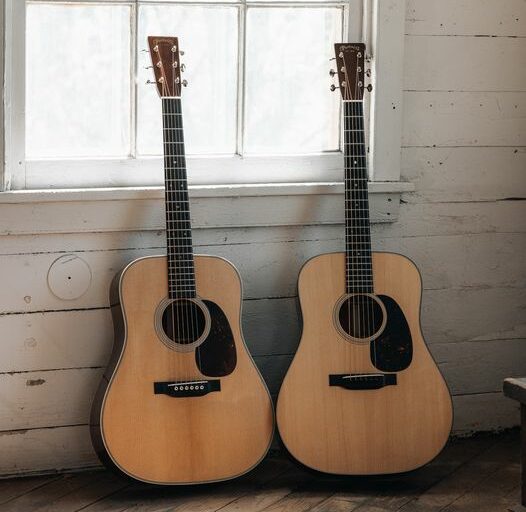
My tongue hurts from countless times I had to ignore or deflect queries asking if we would ever see Martin adding new models to the Authentic Series. Martin removed many Authentics from the catalog without any to replace them, until now. At long last, we have two new Authentic Series models released to the public – the revised D-28 Authentic 1937 and the long-desired companion, the D-18 Authentic 1937.
These new Authentics are but two of many new models that Martin Guitars will be debuting later this week at Hall D, Booth 5602, at the NAMM show in Anaheim, California. They saw fit to put out a press release today mentioning a few of these instruments. But the real news is found in the latest editions to the fabulous Authentic Series.
Each of these new Authentics is made with a new dreadnought body shape. Or rather, I should say an old body shape. The silhouette of each model is quite close to the shape of an actual 1937 D-28 and D-18. This should satisfy critics of the Authentic Series that have claimed it was inaccurate to refer to Authentic Series models as vintage Martin recreations if they are made with the modern-day Martin body shapes.
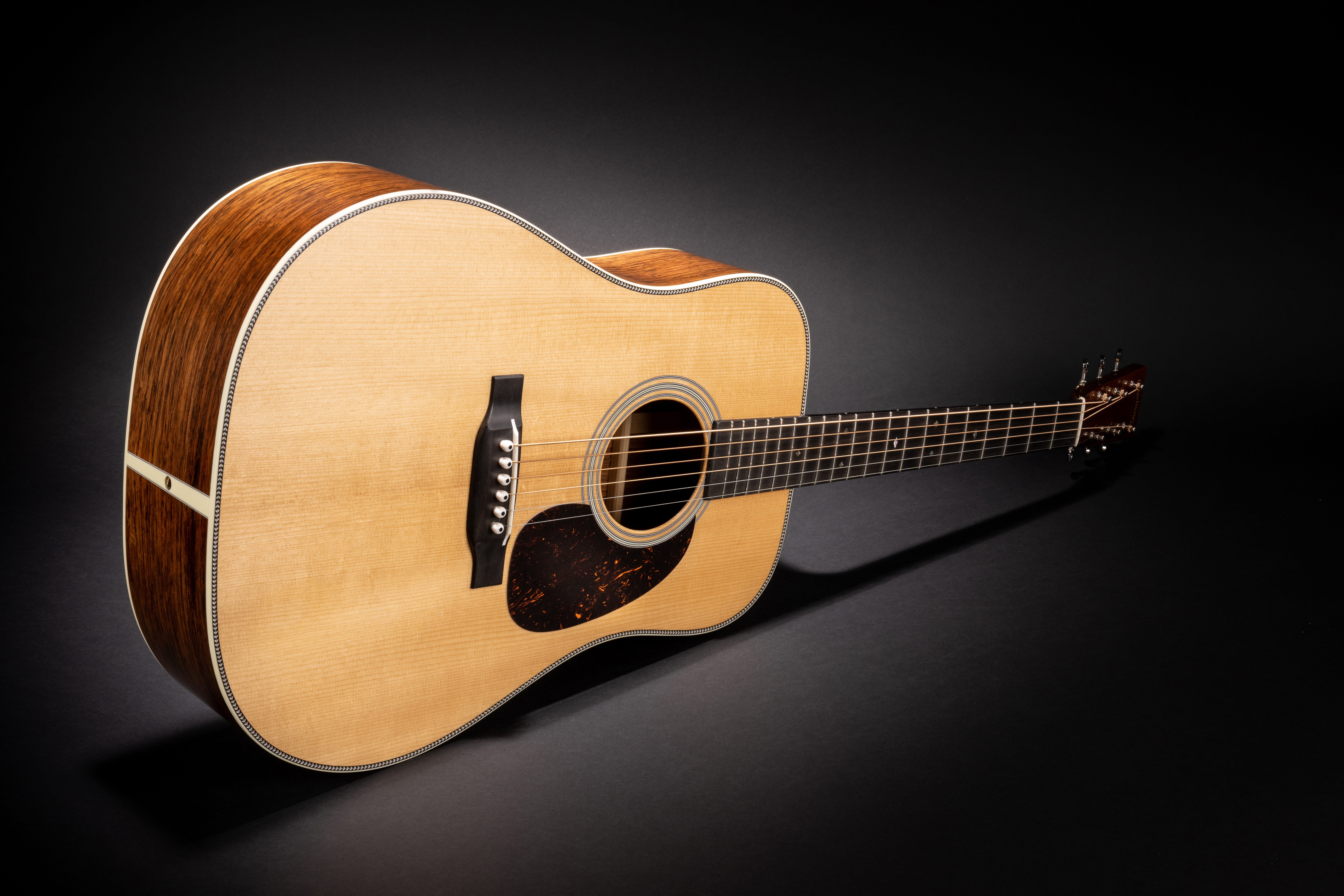
The instrument often cited as the best sounding acoustic guitar ever made is a particular Martin D-28 from 1937. It was taken to the Smithsonian Institute in 2013 for magnetic resonance imaging and X-rays to reveal as much as possible about the inner workings of that “Stradivarius of guitars” so that Martin could recreate the bracing and bridge plate down to the smallest detail. The resulting D-28 Authentic 1937 has gone through some changes since it debuted at Winter NAMM in 2014.
Until now, the most significant improvements were the addition of Martins exclusive Vintage Tone System and the Vintage Gloss version of the traditional nitrocellulose finish. Today, I am finally allowed to tell you about two new significant changes, the revised body shape and the tonewood used for the back and sides – Guatemalan rosewood.
Although the differences are subtle between last year’s D-28 Authentic 1937 and the one appearing at NAMM 2022, the silhouette of the soundboard and back, which determine the exact shaping of the sides, and therefore the specific shape of the sound chamber, are truly different. This is a tracing Tim Teel, Martin’s Head of Instrument Design, created to show the differences between a dreadnought made in the 1930s and one found in the Standard Series today.
(click to enlarge.)
How much this might affect tone production will be debated for at least as long as how much difference it makes to the tone of actual pre-war D-28s compared to modern guitars. But one thing that will certainly affect tone production of this new D-28A 1937 is the replacement of Madagascar rosewood for Guatemalan rosewood.
Both rosewoods have been equated with the Brazilian rosewood used on actual 1930 Martins. To my ear, Madagascar rosewood sounds more like the brightest, least-warm Brazilian rosewood Martins, chimey, expressive and colorful, with a quick reflection of soundwaves. Guatemalan rosewood sounds typically warmer and throatier, with a darker undertone more like Cocobolo and East Indian rosewood, but with quicker reflection than either of them. It also offers the endless depth to the bottom end that is very much like the bassier example of Brazilian rosewood Martins, complimented by high-end overtones with a colorful richness likewise similar to that holy grail of endangered species that once grew in the costal lowlands of Brazil.
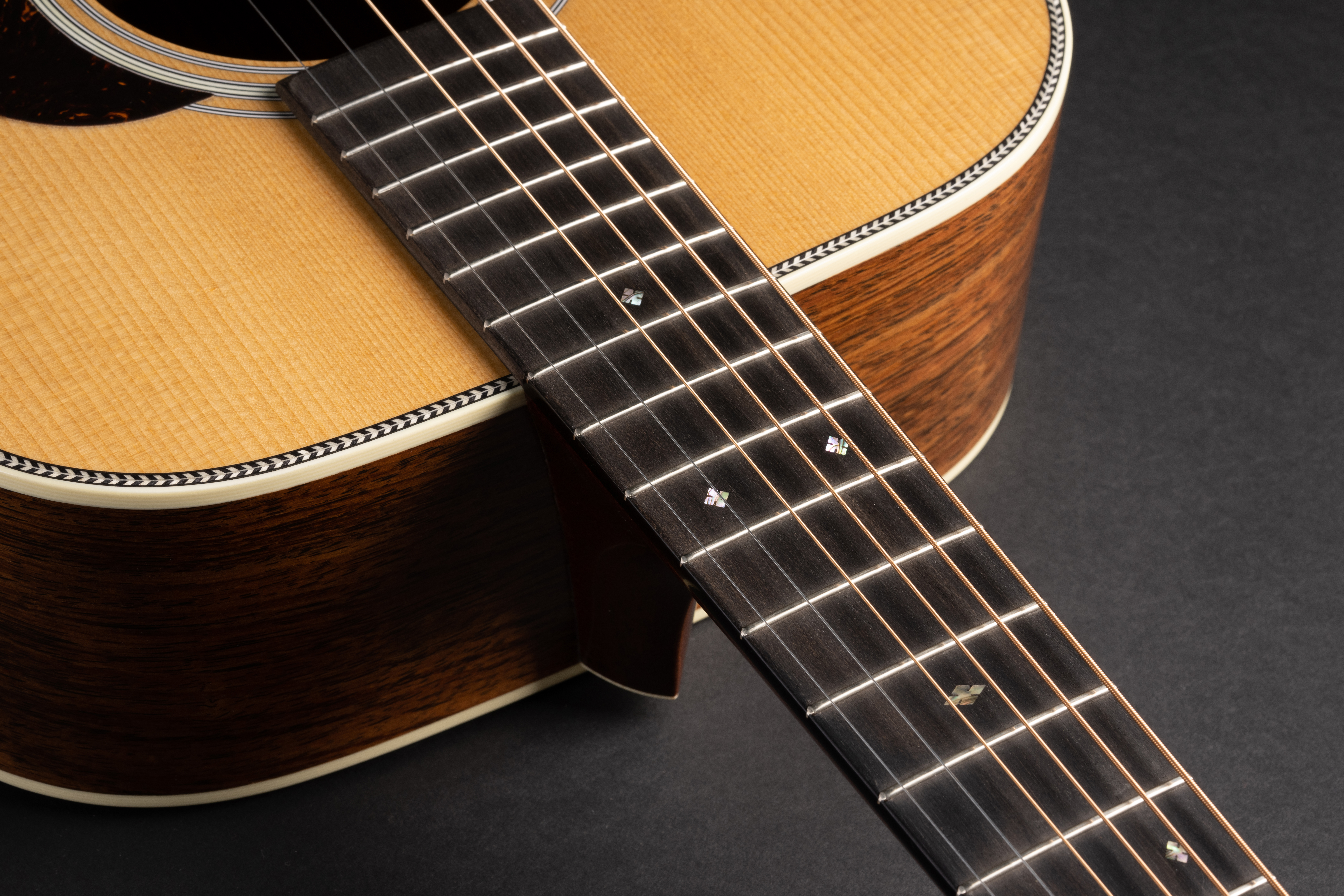
Martin’s supply of Madagascar rosewood is dwindling, and they will not be getting more any time soon. Retired CEO Chris Martin is passionate about environmental stewardship He has spent decades educating and assisting nations of the world in the responsible management of-their precious natural resources. When the legal government of Madagascar was overthrown in a coup d’état in 2009, by a faction intent on exploiting the rare resources of that tropical island for short-term gain, Martin Guitars was the first American manufacturer to cease the acquisition of Madagascar rosewood. When I first got wind of Chris Martin investigating the inevitable replacement of Madagascar rosewood in the Authentic Series, Guatemalan rosewood was the first thing out of my mouth. It is the most logical choice. I believe future owners of this new D-28A 1937 will be most pleased with the rich and powerful tone these battleships throw out.
D-28 Authentic 1937 (2022) Spec Sheet Here
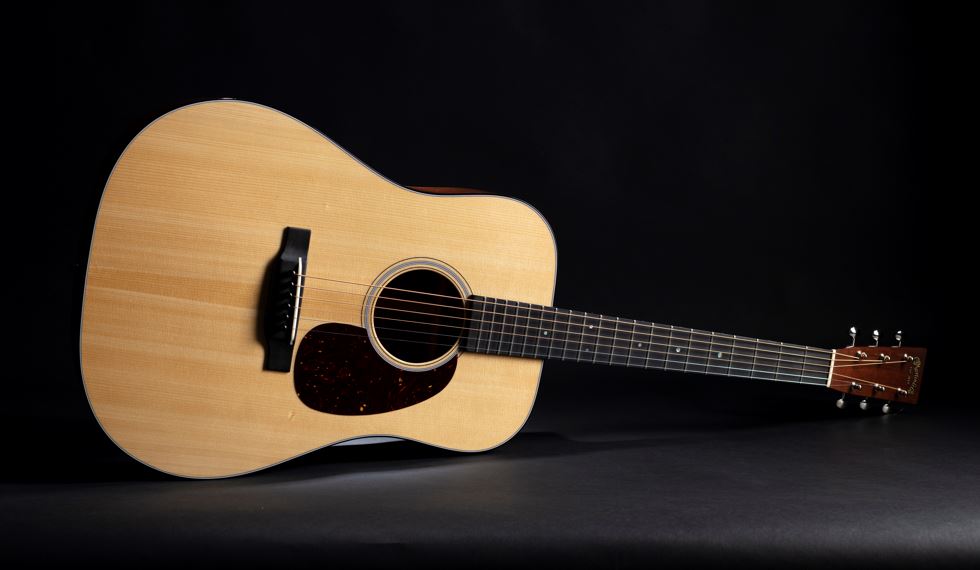
Hooray for C. F. Martin & Co. for making dreams come true! Countless people have been wishing they would release an Authentic Series D-18 with 1937 specs, as good as if not better the original D-18 Authentic 1937 created in small batches from 2006 until the advent of the Modern Authentic Series. At long last, the wish is granted with the debut of the 2022 D-18 Authentic 1937.
Like the revised D-28 Authentic 1937, this latest Authentic model has the new body shape, notably closer to Martin dreadnoughts made before the Second World War. Unlike the current D-18 Authentic 1939 and D-18 Authentic 1939 Aged, this new 18 has forward-shifted bracing rather than rearward-shifted bracing. This physical shifting brings about a tonal shift with a fuller, rounder bass and increased natural reverb.
It also has a 1-3/4” V neck with shaping like the D-28 Authentic 1937. But it is unique, having been copied from a 1937 D-18 once owned by James Taylor. Originally, it was reported this guitar was based on the old D-18As made in 2005, which were not based on a specific prewar Martin, but rather the original four-person team took their inspiration from multiple vintage Martins. But it is indeed the faithful reproduction of a specific 1937 D-18, with a little extra star power thanks to JT.
NAMM is finally upon us (in three days’ time.) C. F. Martin & Co. has seen fit to release the identities of some of the many new models that will be debuting later this week at Hall D, Booth 5602, at the NAMM show in Anaheim, California.
The new guitars I can mention today are the D-18 Authentic 1937, D-28 Authentic 1937, 000-16 StreetMaster®, and the GPC-13E Burst. There are also three new ukuleles, the 0 Tenor Uke, C1 Uke, T1 Uke FSC. You can read more about the two Authentic Series models HERE.
The more-affordable options offer plenty of excitement in their own right. They are as follows.
(click to enlarge photos)
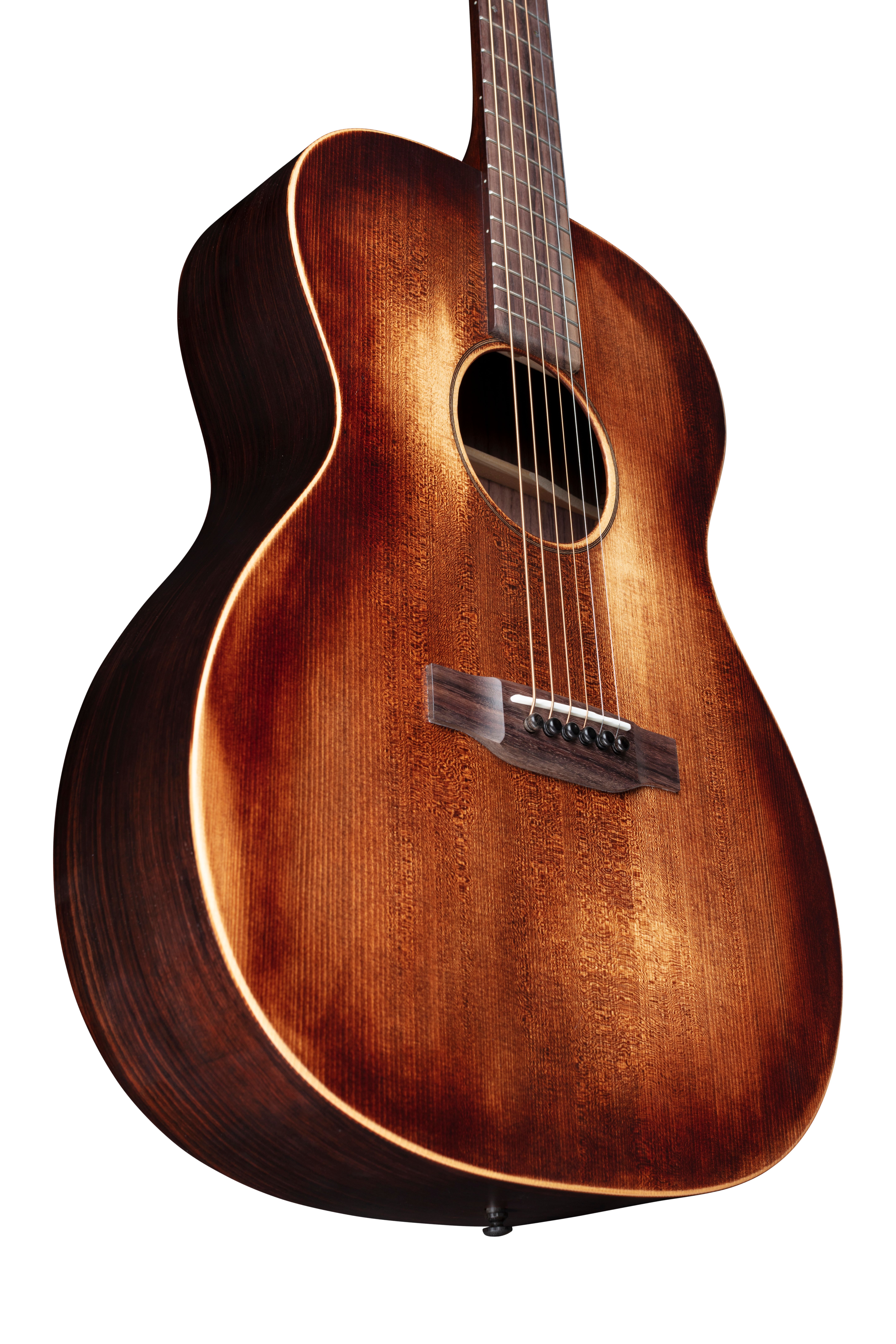
Not only does this new 000-16 get the StreetMaster finish hereto before seen on the all-mahogany 15 Series instruments, it is the first 16 Series instrument made with an Adirondack spruce soundboard. Not only that, it is first instrument made in the 16 Series to feature Martin’s Vintage Tone System, their propriety torrefaction treatment. The back and sides are solid East Indian rosewood! Rosewood/VTS Adi, short-scale 000 with the StreetMaster finish for a very reasonable price that’s very nice. List price: $1,999, including a softshell case.
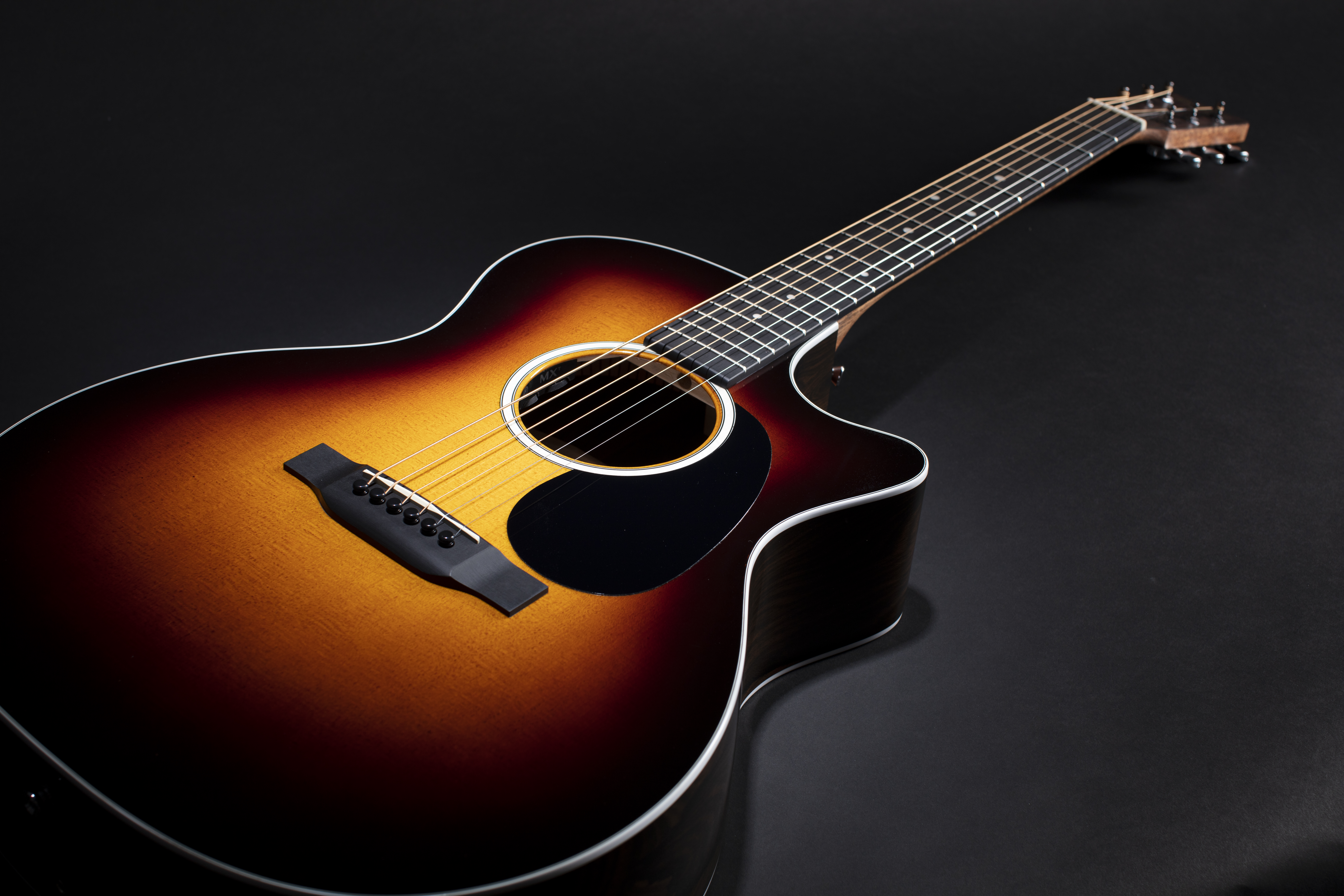 The latest instrument made with Style 13 appointments at the top of the affordable Road Series is a Grand Performance size acoustic-electric guitar with a cutaway that features a back and sides of gorgeous ziricote fine veneer and a solid Sitka spruce top with a classic Martin burst finish. The onboard MX-T electronics include an onboard tuner that mutes the output single when engaged. List price: $1,549 with a soft shell case.
The latest instrument made with Style 13 appointments at the top of the affordable Road Series is a Grand Performance size acoustic-electric guitar with a cutaway that features a back and sides of gorgeous ziricote fine veneer and a solid Sitka spruce top with a classic Martin burst finish. The onboard MX-T electronics include an onboard tuner that mutes the output single when engaged. List price: $1,549 with a soft shell case.
Spec Sheet Coming Soon
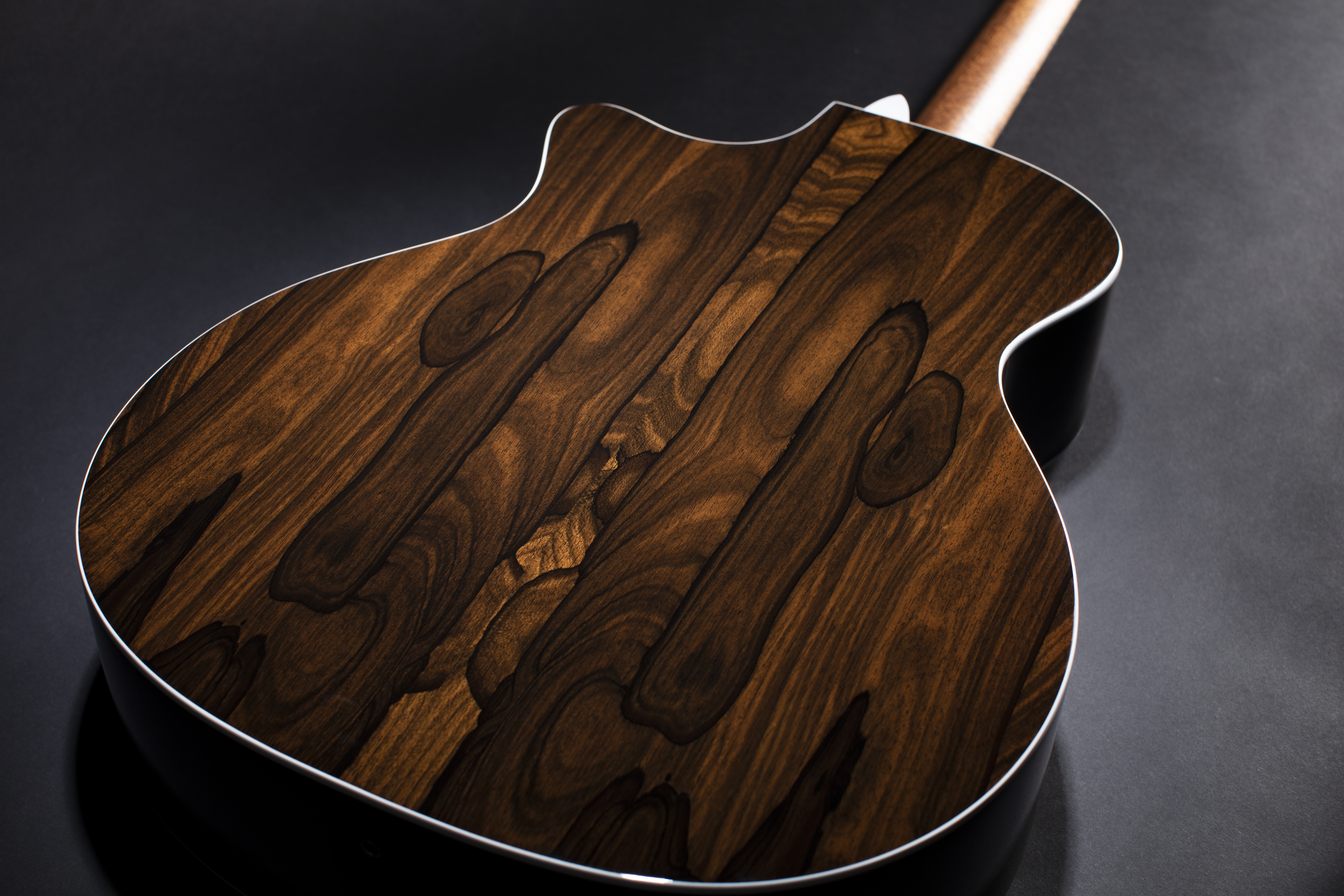
0 Tenor Uke – Sinker Mahogany!
Since 1929, Martin tenor ukes have been prized since they first appeared in 1929. With a 17″ string scale, the tenor uke puts out very nice, resonant volume. The back and sides of this one are made from the old growth Big Leaf mahogany salvaged from a logging river in Belize. This incredibly dense Genuine Mahogany provides rich tone and improved volume to any instrument made from it. A satin finish and old-style Martin logo give it vintage Martin cred. List price: $1,599 with a high-quality soft gig bag.
C1 Uke
Martin crafted this concert-size uke with koa fine veneer that has a hand-rubbed satin finish. Just like the concert ukes made at Martin 1925, it is smaller than a tenor, but larger than a soprano uke. Concert size ukes are known for there balanced tone. List price: $449 with a high-quality soft gig bag.
T1 Uke FSC
Constructed of materials approved by the Forest Stewardship Council, this Tenor ukulele is made with African sapele back and sides and an African sipo neck that has an ebony fingerboard and bridge. All of these beautiful tonewoods are FSC certified as coming from forests managed in a respectful and environmentally sustainable manner. It has Ratio tuners for fast accuracy and comes with a blue gig bag made from recycled plastic water bottles. List price: $459.
Lehigh Valley, PA.— Wednesday, March 23, 2022—C.F. Martin & Co. announced today that Matthew Kennedy has been elected to the company’s Board of Directors.
The nephew of Chris and Diane Martin, Kennedy has been a full-time employee of Martin for nearly a decade and has held a seat on the board of the Martin Guitar Charitable Foundation where he has served with integrity and passion since December 4, 2020.
“Matt will be assuming Diane’s position as a representative of the Martin family, along with me, on the board of our closely held family business,” said Chris Martin. “Matt shares many of the values that made Diane an incredibly kind and beloved human being to everyone who knew her. She and Matt have always shared a fair and just outlook on life and business, carrying on their duties without privilege or ego. I look forward to helping Matt learn about how to guide our precious family business into the future.”
Currently a Project Manager, Kennedy started his journey with Martin on the manufacturing floor and has held various positions throughout the organization. By working alongside coworkers in each area for extended periods, Kennedy was able to understand the unique opportunities and challenges that the employees face on a daily basis. It is through this ongoing immersive experience that he hopes to bring the voice of every employee into the board room.
“I’m truly honored to accept a position on Martin’s Board of Directors,” said Kennedy. “I hope to make my aunt proud by ensuring that her never-ending voice for inclusivity and equality continues to resound with each decision that is made on behalf of the board. I feel a deep sense of responsibility to do what I can to make sure my family’s business and all of my coworkers continue to thrive for the foreseeable future.”
Kennedy holds a BS from Bloomsburg University with a dual major in Computer Science and Philosophy. He is currently pursuing his MBA in Project Management from DeSales University.
I have long been privy to the internal speculation that Mr. Kennedy was being groomed toward possibly being the next family member to head this venerable American family-owned business. Here’s to wishing him every bit of good luck possible.
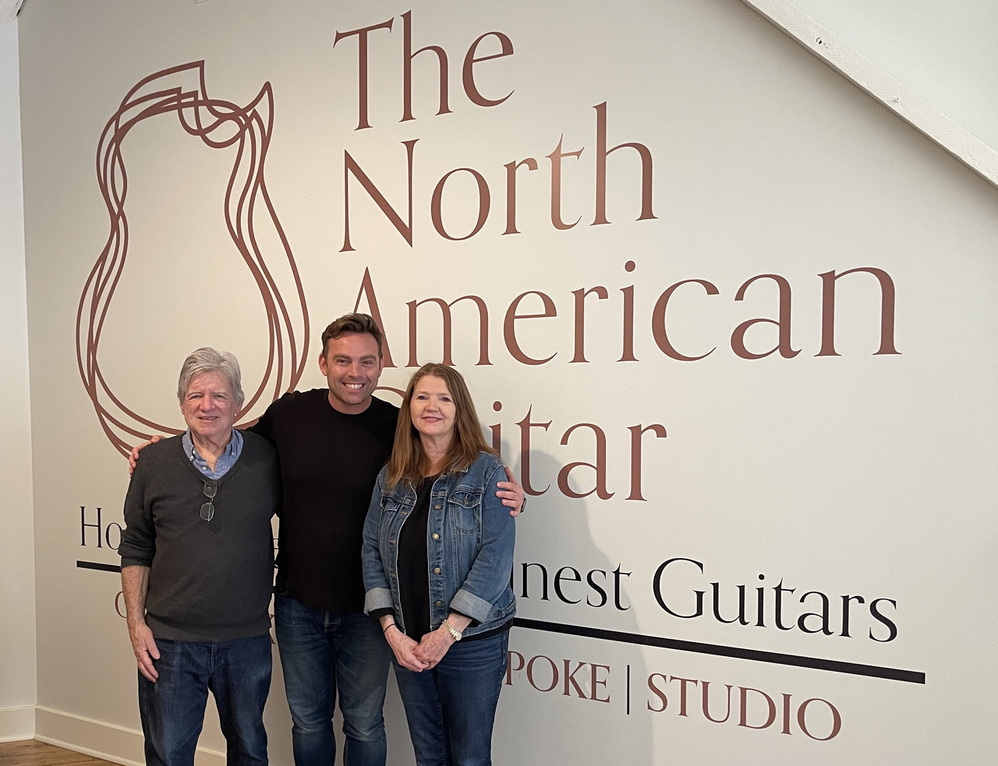
The two independent guitar companies will work together to shape the future of the high-end and vintage guitar market ensuring that guitar lovers no matter their location can access the best guitars the world has to offer
NASHVILLE, TN, MARCH 3, 2022—Two of the world’s leading independent guitar stores, The North American Guitar (TNAG) and Carter Vintage Guitars (CVG), have announced they have merged.
Carter Vintage Guitars will become part of The North American Guitar and together they will pursue a shared mission to bring the world’s finest guitars and instruments to players, collectors, and enthusiasts worldwide. CVG co-founders Walter and Christie Carter will remain at the helm of the vintage instrument operations from their iconic location in Music City, Tennessee.
By combining TNAG’s expertise in luthier-built instruments and the premium guitar market, along with CVG’s extensive vintage inventory and expertise, the partnership will create an unprecedented online and in-store guitar-buying experience for discerning musicians.
“Partnering with CVG truly is an honor, but it’s also a strategic decision as we are not only bringing together two of the most respected guitar brands but two that are inherently complementary,” says TNAG’s CEO, Ben Montague.
“TNAG has worked over the last 10 years to develop the premium guitar market and to reshape how collectors and players source, play, and eventually, sell high-end instruments. Carter Vintage Guitars has the same philosophy in the vintage world and so this partnership really is about bringing together two trusted brands that will work together to build the future of our wonderful premium guitar market.”
“TNAG has set the standard for the modern guitar business in providing buyers with a friendly, personal online experience. We’ve always aimed to be Nashville’s friendliest guitar store, and TNAG will help us take that to the next level,” says CVG co-founder, Christie Carter.
The North American Guitar was founded in 2010 in London, UK, by Ben Montague and his father Robert Montage, CBE. In 2019, TNAG acquired Nashville’s longest standing music store, Cotten Music Centre. As part of the 2019 acquisition, TNAG relocated its HQ to Music City, Tennessee, to build out its mission of delivering the world’s finest guitars to players around the globe.
“I bought my son’s first guitar in 1988 from Cotten Music, the guitar shop that became TNAG in Nashville,” says CVG co-founder, Walter Carter. “History is the foundation of our business and we’re thrilled to be a part of the music store with the longest legacy in Nashville. TNAG is the perfect partner to deliver the world’s finest guitars to players and collectors everywhere.”
Joining these two guitar powerhouses will create the ultimate online destination for the world’s finest guitars and instruments.
TNAG is a family-founded business started by a father and son with the goal of bringing the world’s finest guitars to enthusiasts around the globe. Representing the most skilled luthiers and handmade guitar brands, TNAG is the number one destination for boutique and custom guitars for discerning players and collectors alike, both online and in their Nashville showroom.
CVG is one of the most respected brands in the vintage instrument business. Also a family-founded company, CVG was created by a husband-and-wife duo who bring 50+ years of collective industry experience and unmatched historical knowledge of fretted instruments. Walter and Christie Carter are legendary supporters of musicians and enthusiasts of the instruments they play.
Spoon’s take on the new Custom Shop Experts program was preceded by his in-depth article on Martin’s revolutionary acoustic-electric hybrid model, the SC-13E, which appeared in vol. 11
At long last, I may now share with you the first glimpses of the SEVEN new Modern Deluxe Series Martin guitars, released in lieu of the canceled Winter NAMM show. These guitars blend classic Martin guitar specifications with ultramodern technological enhancements to realize twenty-first century musical instruments that are both modern and deluxe.
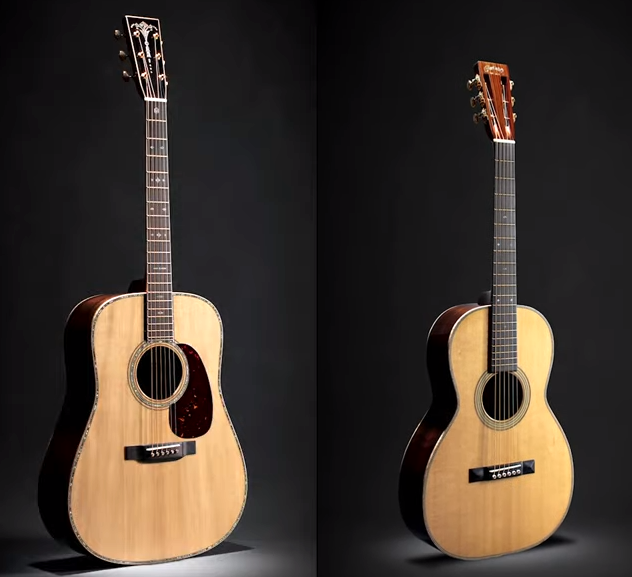 The new Modern Deluxe Martins include a 12-fret 0-size rosewood model in rosewood Style 28, the 012-28 Modern Deluxe. A 12-fret 00 and 14-fret 00 join it, the 0012-28 Modern Deluxe and 00-28 Modern Deluxe.
The new Modern Deluxe Martins include a 12-fret 0-size rosewood model in rosewood Style 28, the 012-28 Modern Deluxe. A 12-fret 00 and 14-fret 00 join it, the 0012-28 Modern Deluxe and 00-28 Modern Deluxe.
Yes, that is a new naming convention for 12-fret Martin guitars, with the 12 on the LEFT side of the dash, replacing the archaic S for a “Standard” body size on the right side of the dash. And about time too, I say! The 12-fret configuration hasn’t actually been the standard design since 1934.
Moving to the next larger size, the mahogany 000-18 Modern Deluxe is also included, and super-fancy rosewood 000-42 Modern Deluxe have arrived. Larger still are the full-size Dreadnoughts, the D-42 Modern Deluxe and, at the top of the Series, the D-45 Modern Deluxe.
The D-45 Modern Deluxe heralds the return of the classic torch inlay that graced the headstock face plates of Martin’s Style 45 guitars up through 1930. It also brings back the snowflake fingerboard pattern to a D-45, like those made pre-1939. But this time, the exquisite diamonds, snowflakes, and cat’s eye fret position markers are not just inlaid with high-color abalone shell; each marker is outlined in even more pearl.
Around the East Indian Rosewood back and sides are the glittering abalone pearl trim that sets Style 45 Martins apart from their other handmade, professional-level acoustic guitars. But unlike other D-45s out there, the D-45 Modern Deluxe has flamed European maple binding on the body and the neck.
All guitars in the Modern Deluxe Series include a unique set of advanced features engineered to increase tonal depth (a Vintage Tone System aged Sitka spruce soundboard supported by VTS Adirondack spruce braces with Golden Era scalloping and set in place with natural protein glue,) increased volume and sustain (Liquid Metal bridge pins and a VTS Adirondack spruce bridge plate protected by thin outer layers of carbon fiber,) extended fret life thanks to the copper-infused EVO Gold frets with matching gold tuners, and a wonderfully comfortable neck shape based on the 1930 OM-45 Deluxe owned by the Martin museum.
The MD neck is asymmetrical with an apex that gradually drifts off center, to effortlessly fit into the palm of the hand at every position along the fingerboard, just like a marvelous pre-war Martin neck, except that it is a lower profile, made without the tubby vintage heel where the neck fits into that all-all important solid mahogany neck block with the traditional, hand-fitted dovetail neck joint.
The D-42 Modern Deluxe and 000-42 Modern Deluxe also have the pre-war Style 45 torch and same fretboard inlays, plus the addition of two large abalone snowflakes on the bridge extensions. But they do not have the extra pearl inlay around the back and sides, greatly reducing the price compared to the D-45 Modern Deluxe.
The mahogany 000-18 now joins the D-18 Modern Deluxe, combining these advanced tone enhancements with the clear, woody tone of a mahogany Martin. The 14-fret 00-28 Modern Deluxe brings an even smaller body to the MD Series, as do the two 12-fret models, each with a traditional slotted headstock.
I look forward to sharing more details about these exiting new Martin guitars soon, including full reviews of as many of them as I can get into my hands and ears.
In a “virtual preview” later today, C. F. Martin & Co. CEO Thomas Ripsam and Vice President of Product Management Fred Greene will unveil the first new Martin models for 2022:
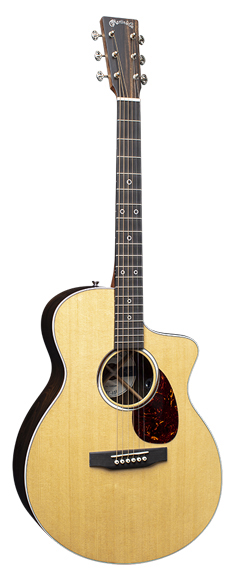 $1,799 $1,799 |
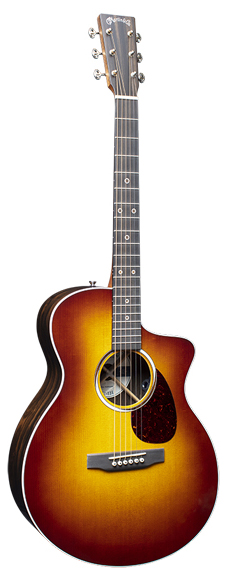 $1,999 $1,999 |
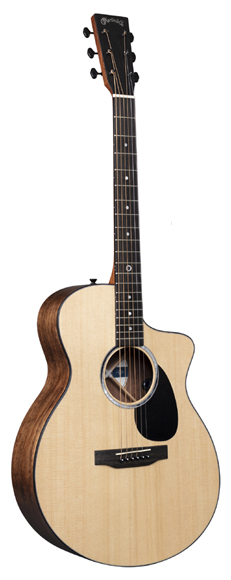 $1,299 $1,299 |
The SC-13E Special, SC-13E Special Burst, and the SC-10E expand the horizons of the Martin’s ultra-modern 13-fret acoustic-electric guitar design, pioneered by the 2019 SC-13E Koa. Upgrades on the Specials, and a satin finish on the more affordable 10E set these SC guitars apart from the earlier version.
Ziricote Specials
After the phenomenal international accolades that poured out for revolutionary SC-13E Koa, it was only a matter of time before we saw new SC models coming from Martin’s state of the art facility in Navojoa, Mexico. The SC-13E Special and the Special Burst version are the most luxurious models yet offered in Martin’s Road Series of relatively affordable professional-level acoustic-electric guitars intended for performing musicians.
Each Special has a back and sides with highly figured ziricote fine veneers. A Cordia genus from Central American, ziricote is considered very close to Brazilian rosewood in looks. These gorgeous veneers are laid down over a core of solid Khaya, a true Meliaceae-family hardwood known as African mahogany in the furniture trade.
The Khaya core provides stability, but the ziricote plays a part in tone production. It is used to line the insides of the sound chamber, where it reflects and adds tonal coloring to the sound waves broadcast by the solid Sitka spruce top. The new ziricote models have a noticeably warmer, fuller acoustic tone compared to the koa versions.
The attractive ziricote also makes an appearance on the front of the instruments, where it is inlaid as the center of the fret position makers, and as part of the dynamic Aperture sound hole rosette for a new, woody take on the motif of the original SC-13E. It may be hard to see the ziricote fret dots in the photos, compared to the solid ebony of the fingerboard, but it is more noticeable in person.
Things get even fancier at the other end of the solid ebony fingerboard, where a silver script logo ties in nicely with the nickel-plated open keyhole tuning machines and their airy skeleton key buttons. These are special ratio tuners loved by Tim Teel, Head of Instrument Design at Martin, who has used them on some limited editions in the past. Each string gets its own ratio to work with the specific string diameter and tension. Supposedly, each string will adjust in pitch to the exact same amount of knob turning. One twist adjusts every string to the same degree.
The SC-13E Special Burst has a new Amberburst finish on the top, which Teel based on some other amber-heavy shading Martin came up with for previous models. This one shows the top wood grain nicely, while working very well with the darker ziricote aesthetic.
Upgraded Electronics
Both Specials come with the LR Baggs Element pickup and EAS tone and volume controls that protrude from inside the sound hole. This is one of the most popular pickups out there and compatible with Baggs’ Anthem internal microphone, for those who might want mod out the acoustic qualities of their electric sound. However, such alterations might imperil the Martin warranty, so proceed with caution.
A More Affordable SC
The SC-10E brings the price point down, for the most-affordable SC model to date, even though it too has fine veneers of Hawaiian koa and an ebony bridge and fingerboard like the original SC-13E Koa, which is still for sale and immensely popular. The savings come from the use of a satin finish on the 10E, instead of gloss, and somewhat simpler appointments. It does come with black tuners that look edgy and cool with the dark wood of the headstock faceplate, and a sparkly black swath to its Aperture rosette instead of the ziricote used for the Specials. Under the hood is Fishman MX-T electronics, with their own volume and tone control hidden inside the bass side of the sound hole, and the bonus of an on-board tuner inside the treble side.
Return to the Future
The creation of the S body design combined Greene’s desire to make a Martin guitar with an asymmetrical body with Tim Teel’s admiration of cutting edge design and engineering found throughout the modern world, from high-end cutlery to the automotive industry, and beyond. He came up with the “S” designation, after constantly drawing fluid, serpentine shapes at the draftsman table.
The C stands for the cutaway. And what a cutaway it is. Because the trademarked Sure Align linear dovetail neck joint removes the need for a heel where the neck meets the body, a player can easily fit their entire hand into the cutaway area, without having to distort the grip or fingering. The most complex jazz chords or rock leads are achieved effortlessly, all the way up to the 20th fret.
If you haven’t realized it yet, these are acoustic-electric guitars aimed for electric guitarists, who want something versatile enough to handle any kind of music they play. The body shape and unique Tone Tension bracing allow you to take the cable out of your Les Paul or Strat and plug it into a Martin SC model and starting playing, without the need to adjust a single knob or pedal, or the worry about feedback issues that plague traditional acoustic guitars.
They come set up with very low action on the extremely comfortable neck, and extra-light strings. But they are capable of working with light and medium gauge strings, and also can be set up with much higher action. But any major adjustments require a specially trained Martin certified technician who can alter the neck angle through the Sure Align system.
The 13 stands for Style 13, at the very top of the Road Series, and include the only models in the series that have full high-gloss finish on the back, sides, and top. It is a happy coincidence that the SC design created Martin’s first regular production 13-fret guitar. As you can read in my original review of the SC-13E Koa model, having the neck join at the 13th accomplishes multiple perks.
The SC guitars are perfectly balanced when hanging from a guitar strap. No more having to worry about the body or neck sagging down and moving the fretboard out of position when both hands are busy adjusting the microphone. It also allows a long-scale neck, with its roomier frets up in the cutaway, to feel much more like a short-scale neck, because all of the frets are a little closer to the player’s body, so everything is played with a little less stress and effort on the shoulder, elbow, tendons, and hands.
Each of the new SCs has Martin’s exclusive Velocity neck, now officially called the Velocity Low Profile neck. It is indeed low, and it has a helix skew to the shaping. It is subtle, but the corkscrew effect adjusts perfectly the change in angle of the fretting hand as it moves up toward the body. It really needs to be played to be appreciated, even if you may not even notice how incredibly comfortable and relaxed it makes playing even the most complicated music.
What makes these models so desirable is a combination of the perfectly balanced acoustic tone across the six strings, and the fact you can plug them in and play at higher gain without running into the feedback issues normally plaguing acoustic guitars with pickup systems.
Like em, love em, or don’t want to have much to do with them, as I predicted two years ago, the Martin SC design is here to not just stay, but to proliferate and evolve into multiple models, and eventually with many different varieties, across many years to come. Having new SC models a little more expensive than the first SC-13E and having one notably less expensive, but all from the Navojoa factory, is a welcome and logical next step.
As for new Martins from the home factory in Nazareth, PA, well, you will have to wait until later in the year to learn more about that possibility. But not too much later. Say, oh, the morning of January 31 might be a good time to check in for any updates at One Man’s Guitar. 😉
I can say no more, and so I shan’t.
[click to enlarge]
And that is one man’s word on…
Spoon Phillips chats with Martin’s Jason Ahner about the SC-13E
Dick Boak and his friend Steve Miller host a benefit concert at the State Theatre in Easton, Pennsylvania will the the site of the event. In the spirit of Dick’s fabulous retirement concert comes a sequel to be savored in the imagination before it arrives, and in the memories it will leave behind for years to come.
Last time, the concert was in celebration of Dick Boak’s retirement from Martin Guitar, where he spent 35 years making it a better place for making better guitars. But a deep freeze left one Marty Stuart snowbound and unable to attend. This time around, Marty Stuart and His Fabulous Superlatives will be headlining, along with other fine heavy hitters.
All tickets are being handled by the State Theatre Box Office. Tickets to State Theatre Members (only) go on sale on Wednesday, December 1st. Tickets to the Public go on sale a week later on Wednesday, December 8th.
If you want to jump on the opportunity, you can become a member of the theatre for $75.00 ($55.00 for Seniors 65 and older). Tickets can be ordered online (depending upon your member or non-member status) at www.statetheatre.org or by calling the Box Office at (610) 252-3132.
Purchasing a membership in the theatre allows you to purchase up to six tickets prior to ticket sales to the public. The maximum number of tickets per purchaser is six. Ticket holders must be fully vaccinated for Covid-19 and show proof of vaccination in order to be admitted into the theatre.
Performer participation is subject to last minute changes.
Charitable Support
Proceeds from Boak Bash Two will equally benefit:
The Musical Instrument Collection of the Moravian Historical Society in Nazareth, PA. Link: www.moravianhistory.org
The State Theatre Center for the Arts, Easton, PA. Link: www.statetheatre.org
Both are 501c3 charitable organizations.
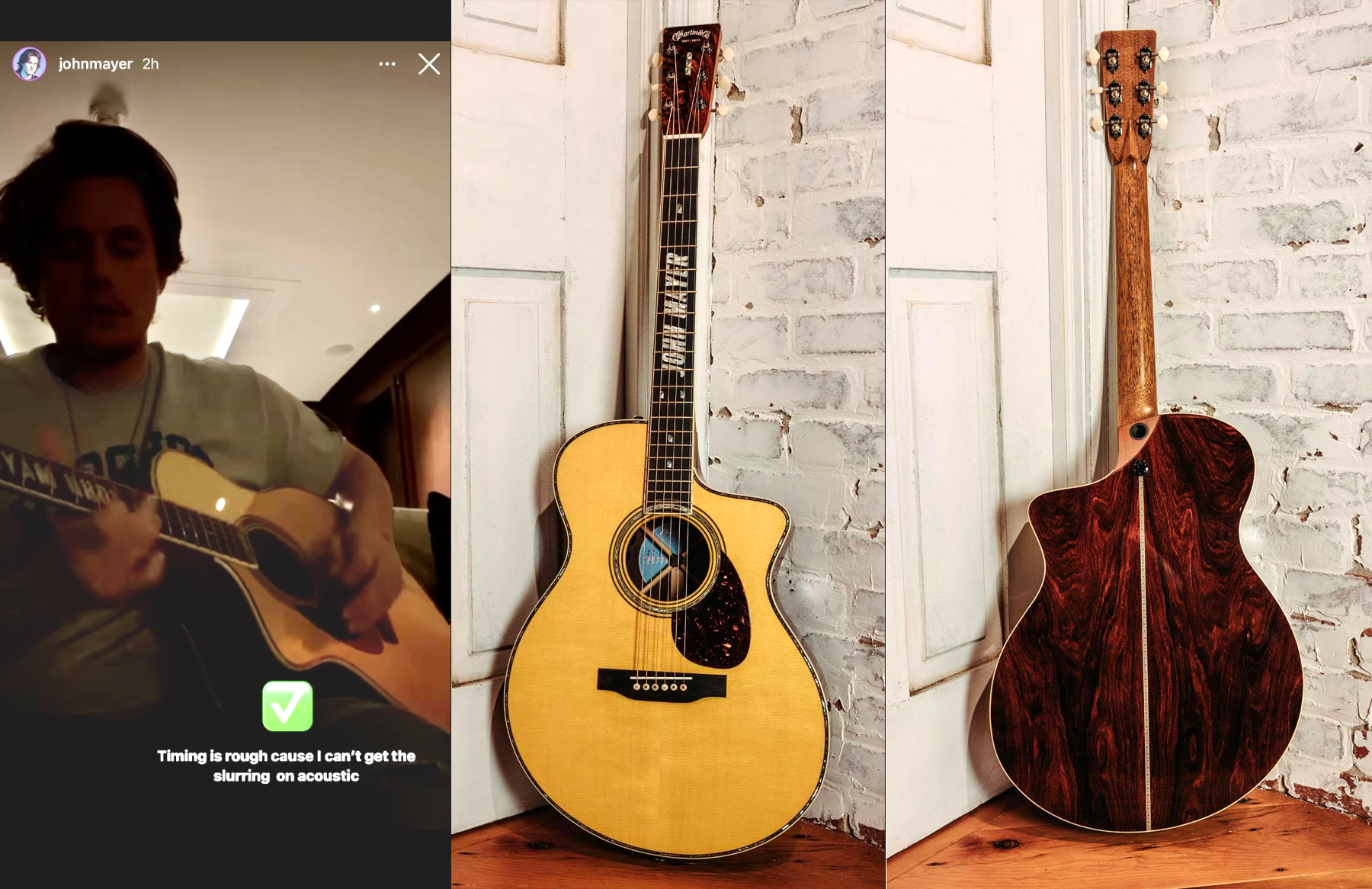
An eagle-eyed Aaron Short sent me the photo on the left to ask about what this guitar might be. And since it is now out there in the public media, my self-imposed gag order regarding any behind the scenes stuff at C. F. Martin & Co. has now some leeway for replying. This is one very cool guitar.
I feel it is important to make clear that this was a private project that Martin had no intention of publicizing. Mr. Mayer had no part in the project or its design, and it was made entirely as a surprise for him, conceived by his friend Fred Greene, Martin’s VP of Product Management.
When Mayer chose to reveal the guitar on his social media, I asked the powers that be if that meant I could post about it. The response I received from Fred was, “Since it’s no longer secret, feel free to share.” And so I shall.
The revolutionary Martin SC-13 is the basis for this one-of-a-kind custom Martin that was made for John Mayer, with the artist’s name inlaid on the fingerboard in abalone shell, using the font from the cover of his latest album, Sob Rock. It also gets a matching abalone rosette around the sound hole, and abalone trim along the edge of the top, making it similar to Style 41 Martins. And that rosette goes all the way through the fingerboard extension on the top, making a full circle. This is a cosmetic embellishment that John Mayer himself came up with for one of his earlier signature models.
The woods are spectacular! The highly-figured cocobolo and shimmering Engelmann spruce look good enough to eat, and even the neck is made from figured mahogany. And the figured cocobolo face plate on the headstock is so outrageous it looks like tortoise shell! There is an inlaid abalone script logo and three split abalone diamonds stacked like rectangles down the center; and all of it is set off by pearloid buttons on the six tuning machines.
The asymmetrical SC design (S body shape named for the bass side curves of the silhouette, C for the treble cutaway) incorporates Martin’s first 13-fret neck with a new neck joint that allows for no heel at all, much like an electric guitar. It is a departure in many ways from the traditional designs of this venerable guitar-making powerhouse. Its proven success is expected to give rise to other SC models in the future – a future put off-course by the COVID-19 crisis. Product projections aside, this SC was produced under the radar, expressly for John Mayer.
(click to enlarge photos – click Back Button to return to article)
The SC-13E is part of the Road Series of acoustic-electric guitars made in Martin’s facility in Navajoa, Mexico, and priced for working musicians. Mayer’s guitar was built in Nazareth, PA with primo tonewoods and appointments. That would mean a much higher commercial price, should anything like it appear for sale to the general public.
Mayer has been a big fan of Engelmann spruce since he was introduced to it by Dick Boak when they were designing his original signature model, the OM-28 JM. That limited edition is now a desirable collector’s item with a skyrocketing price, if you can find one at all. But they made a regular production model based on it, the OMJM, which has the same Engelmann spruce for the top that is matched with the same Indian rosewood back and sides, the rosewood species used on the OM-28V he played for many years prior to the signature models based on it.
Since then, Mayer has had multiple Martin signature models, including two made with cocobolo back and sides, the 00-45 Stage Coach and 00-42 Stage Coach editions. Each is a 12-fret 00 with a slotted headstock. The 45 has an Adirondack spruce top and the 42 has Sitka. Engelmann made a reappearance as the top wood on the D-45 JM, made with Guatemalan rosewood back and sides.
Engelmann spruce has a quick and snappy report, but slower velocity to the swell that rises up and out from sustained chords and harmonic overtones. That effect is barely perceptible when new, but after a year or two the tone of an Engelmann soundboard really blossoms into an ever more-colorful pastel glow that enhances the tonal complexity of whatever rosewood species is used to frame the sound chamber.
Cocobolo is a true rosewood. To my ear, it sounds most like Guatemalan rosewood, with a similar inky-dark undertone, although Guatemalan does not have quite as steely a report from the fundamental notes as cocobolo sends out. The cocobolo should put some meat on the precise Engelmann fundamentals, and the Engelmann should ultimately accentuate the lushness of that deep, dark coco cavern down in the bass and low-mids.
With a body size and sound chamber falling somewhere between a Grand Performance and an Orchestra Model, an SC in this combination of cocobolo topped with Engelmann spruce is mouthwatering in its acoustic potential. But it might provide some challenges when plugging in the onboard Fishman electronics, tonal complexity being a bit of a maverick when it comes to the rodeo of a segmented sound system servicing a large auditorium or concert arena. Fortunately, SCs have an internal switch that cuts the bottom end for just such environments.
I had played an early R&D version of an SC made with solid Indian rosewood and Sitka spruce, and cosmetics similar to Standard Style 28. It was also braced a little heavier. The success of the SC design made with Standard Series woods was apparent from the get go. And it is not telling tales out of school to say the reality of production model SCs made in Nazareth with solid tonewoods that are on par with the Standard Series is (hopefully) only a matter of time. But I would not put money on that happening any time soon.
Since I published this account on September 2, C. F. Martin has saw fit to go public about the guitar on their own social media, with guitar designer Rameen Shayegan posting “I am thrilled to have some glam shots of this custom one-off we built as a surprise gift for John Mayer. I’m ESPECIALLY thrilled that he loves it and is actually playing and enjoying this instrument. Working on projects like this reminds me how much I love my job”
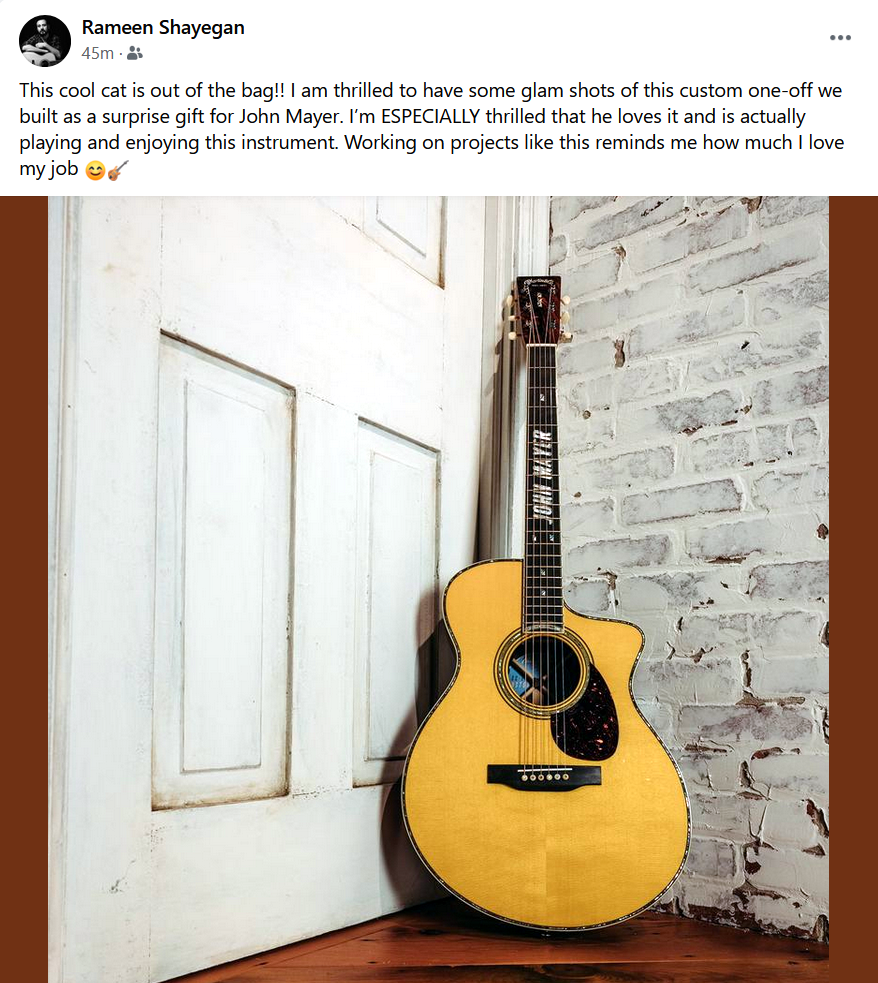
I imposed upon Rameen’s holiday weekend to ask him about the guitar. “Fred (Greene) walked into the Design Team office one day and said he wanted a one-off SC made from Cocobolo and Engelmann spruce. And then he followed up by saying, ‘I want you you guys to pull out all the stops’ and to ‘really pearl it up!’ And that is when he said, ‘Oh, and it is for John Mayer.’ Whew! I went to work on it immediately.”
Cocobolo can be very difficult to work with. It is oily, which makes it problematic where gluing is involved. And some people have serious allergic reactions to the dust when it is sanded. And it can crack when you are working with it.
“We have no bending presses in Nazareth to make the SC body, or bracing masks for that design, or anything really.” What Rameen did have is experience from making the SC prototypes. “I had to bend the sides of John’s new Martin the old fashioned way, by hand, over a primitive form, minimal iron ‘egg.'” This is a device heated by electricity and used to bend guitar sides that are first soaked in water. It was the main way to bend sides at Martin until the turn of the century. “There was no margin for error, but it turned out beautifully.”
Tim Teel, CFM Director of Instrument Design, came up with the fingerboard design. Rameen said that it was tag team effort. “We wanted to base it on Mayer’s Sob Rock album. Did you know Mayer designs his own fonts? That is a pretty cool hobby to have. So, everything about the design, including the split diamond position markers on the fingerboard were inspired by the design concept on his new record. And we included a 360 degree rosette like the one he came up with for his 00-45 SC model.”
I asked about the pickup and was told it is the Fishman Matrix Infinity, which has onboard tone and volume control. Rameen considered using the Fishman’s Goldline Plus pickup that Mayer often uses on stage, so he can fit a feedback buster into the sound hole. “But the SC design is not prone to the same sort of feedback issues one can have with traditional acoustic guitar bodies.”
Tim Teel told me that they built the guitar for Mayer partly because they felt he would be a wonderful adjudicator when it came to a Nazareth-made SC made with solid woods and higher-end construction, and that Tim really enjoyed the design process. By all accounts, “he loves it.” Rameen went on to say that “Mayer is such an important artist whose playing has proven him to be one of the greatest guitarists of all time. That he loves this guitar and enjoys playing it means to me more than I can say.”
In an early conversation, Fred Greene stressed that this guitar was “a one off for John. He is a special person and good friend.”
That being said, there have been many one-off guitars made in Martin’s Custom Shop for notable recording artists that were ultimately used as the basis for an artist signature model, the D-35 David Glamour being the most recent example.
Might this be another Mayer model in the making? I am one man who cannot say.
But I can say, I will be appearing on YouTube’s Aaron Short Music channel on Labor Day (Monday, Sep. 6,) answering questions from the live audience about all things Martin related, via the chat bar feature. The show starts promptly 4 PM, Eastern Time, and will remain up for replay viewing on Aaron’s YouTube channel. I have no doubt this guitar will come up as one of the topics for discussion.
Here is the video Mayer posted on his Instagram story outlet, picked up by a Celine Dion fanzine.